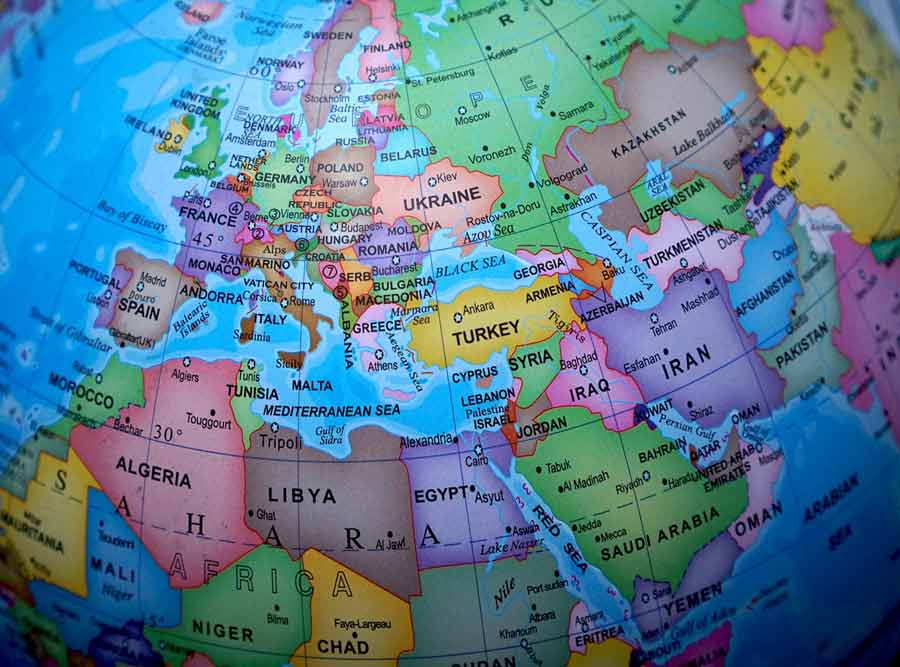The continents, those vast land masses that dot our planet, can be distinguished from one another in numerous ways, with population being one of the most significant factors in this differentiation. Each continent, unique in its own right, boasts its demographic makeup, creating a diverse tapestry of human life across the globe.
The Worldwide Population in 2023
As of the year 2023, our planet is home to a staggering 8,005,176,000 individuals, a number that continues to rise. This vast human tapestry spans across the inhabited continents of Africa, North and South America, Asia, Europe, and Australia/Oceania. These continents, each with its distinct character, are homes to a multitude of cultures, traditions, and people.
The Dominance of Asia
Among these great continents, Asia stands as a true titan, towering over the rest in terms of population. This vast landmass, stretching from the Middle East to the Far East, is a cradle of civilizations and a home to more than 4.5 billion people, making it the most populous continent on Earth. Within the sprawling expanse of Asia, one finds the two most heavily populated nations globally, namely, China and India. The sheer magnitude of humanity residing here is a testament to the cultural diversity and rich history that defines the Asian continent.
The Intriguing Case of Australia/Oceania
In stark contrast to the demographic behemoth that is Asia, Australia/Oceania emerges as the smallest continent by population. It is an intriguing example of how the very definition of a continent can be an intricate matter. With around 40 million people calling it home, Australia/Oceania may, at first glance, appear diminutive in comparison to the behemoths of Asia or the Americas. However, when delving into the finer details, a more complex picture emerges. Protect Your Mac Automatically
Australia/Oceania, in its geographical essence, encompasses vast expanses of ocean and remote islands, making the delineation of its borders somewhat ambiguous. This continent is often, but not always, considered to include the subregions of Polynesia, Micronesia, and Melanesia. Moreover, there exists a debate over whether Australia/Oceania should encompass all the areas located between the American continents and Asia. Should one choose to exclude these regions, counting only Australia and New Zealand, the population total plummets to just under 30 million. This highlights the intricate nature of continent demarcation and the impact it has on population figures, underscoring the multifaceted character of our planet’s human geography.
Top 10 Factors affecting the population growth of the world
The complex interplay of these factors results in the diverse population growth patterns observed around the world. Understanding these elements is crucial for policymakers, as it allows for the formulation of strategies to manage and shape population growth to ensure a sustainable and equitable future for our planet.
1. Fertility Rates:
Fertility rates, often referred to as the number of children born to women of childbearing age, constitute a fundamental aspect of global population dynamics. Various factors, such as cultural norms, economic conditions, and access to contraception, play a pivotal role in influencing fertility rates. High fertility rates in some regions lead to rapid population growth while declining fertility rates in others can result in population stagnation or decline.
2. Mortality Rates:
Mortality rates, particularly infant and child mortality rates, significantly impact population growth. Improvements in healthcare, sanitation, and nutrition have led to reduced mortality rates in many parts of the world. These reductions contribute to population growth by allowing more individuals to survive and reach reproductive age.
3. Immigration and Emigration:
The movement of people across international borders, whether due to economic opportunities, political instability, or other factors, greatly influences population growth. High levels of immigration can lead to population growth in destination countries, while emigration may reduce the population in the source countries. These migration patterns can result in significant demographic changes.
4. Economic Development:
Economic factors, such as income levels and employment opportunities, also exert a profound impact on population growth. In developed countries, higher income levels often coincide with lower fertility rates as individuals prioritize career and lifestyle over having large families. Conversely, in less developed regions, economic hardship may drive individuals to have more children due to the need for additional labor and support in old age.
5. Education and Women’s Empowerment:
Access to education and women’s empowerment play a crucial role in shaping fertility rates. In societies where women have access to quality education and greater economic opportunities, fertility rates tend to be lower as women delay childbearing to pursue career and personal goals.
6. Healthcare and Family Planning:
The availability and accessibility of healthcare services, including family planning and contraception, have a direct influence on population growth. Access to family planning methods allows individuals and couples to make informed decisions about the size of their families, contributing to lower fertility rates in many parts of the world.
7. Government Policies and Incentives:
Government policies and incentives can either encourage or discourage population growth. Some countries offer incentives for larger families, while others implement policies to control population growth, such as China’s one-child policy. These policies have a significant impact on population trends.
8. Cultural and Religious Beliefs:
Cultural and religious beliefs often shape attitudes toward family size and reproductive choices. In some cultures and religious traditions, having larger families is considered a societal or religious obligation, leading to higher fertility rates. Conversely, in more secular societies, individuals may prioritize personal goals over family size.
9. Urbanization:
The global trend of urbanization is reshaping population dynamics. As more people move from rural to urban areas, family sizes tend to decrease due to the demands of urban living, including the cost of housing and the pursuit of careers.
10. Environmental Factors:
Environmental factors, such as climate change, access to resources, and natural disasters, can impact population growth by influencing patterns of migration and the availability of essential resources like food and water.
Continents by Population
Let’s find below the chart of the Continents by Population
| World’s Population | Density (/km²) | ||
|---|---|---|---|
| Asia | 4,751,819,588 | 59.36% | 148 |
| Africa | 1,460,476,458 | 18.24% | 48 |
| Europe | 741,869,197 | 9.27% | 32 |
| North America | 604,155,369 | 7.55% | 25 |
| South America | 439,719,009 | 5.49% | 25 |
| Oceania | 45,575,769 | 0.57% | 5 |
Source: https://worldpopulationreview.com/continents
What is the top 10 population in the world?
The world’s population is a dynamic and ever-changing entity, with some countries consistently ranking among the most populous. As of my last knowledge update in January 2023, here is a comprehensive look at the top 10 most populous countries, taking into consideration the intricate interplay of demographic factors and global trends.
China:
China, often referred to as the most populous country on the planet, boasts a staggering population of over 1.4 billion people. Its sheer size, both in terms of landmass and population, has significant implications for the global landscape, as China plays a pivotal role in economics, politics, and international affairs.
India:
India, a vast and culturally diverse nation, closely follows China with a population exceeding 1.3 billion. India’s population growth has been marked by various demographic and socio-economic challenges, and its influence on the world stage continues to expand.
United States:
The United States, while geographically smaller than China and India, is the third most populous country, with approximately 331 million inhabitants. It is a highly diverse nation, with a rich tapestry of cultures and ethnicities, contributing to its global significance in various fields.
Indonesia:
Indonesia, the world’s largest island nation, is home to more than 273 million people. The archipelago’s unique geography and cultural diversity make it a compelling case study in demographics, and its continued growth is a noteworthy trend.
Pakistan:
With over 225 million people, Pakistan ranks as the fifth most populous country. This South Asian nation’s demographics, along with its geopolitical significance, are of great interest to observers worldwide.
Brazil:
Brazil, the largest country in South America, has a population of approximately 214 million. Its natural beauty, cultural richness, and demographic dynamics make it a critical player in the global arena.
Nigeria:
Nigeria, in West Africa, is home to around 206 million individuals. With a youthful population and a rapidly growing economy, Nigeria is poised to have a significant impact on the African continent and beyond.
Bangladesh:
Bangladesh, a densely populated nation in South Asia, has over 166 million inhabitants. Its demographic challenges and economic aspirations make it a country of global interest.
Russia:
The vast expanse of Russia is home to around 145 million people, placing it in the ninth position on the list. Its unique geographical and geopolitical characteristics have a far-reaching influence on global politics.
Mexico:
Mexico, with a population of approximately 126 million, rounds out the top 10. Its proximity to the United States, cultural significance, and economic ties make it a crucial player in North America and the world at large.
It is essential to note that these numbers are based on data available up to 2022, and population figures may have changed since then. The complexities of population growth, migration, and socio-economic factors continue to shape the global demographic landscape, making this an area of perpetual interest for researchers and policymakers. Understanding the dynamics of these populous nations is vital for addressing global challenges and opportunities in the 21st century.
What is the least 10 population in the world?
When considering the global demographic landscape, it is essential to divert our attention to the less-traveled path, where small populations define the identity of a select few nations. The quest for the least populous countries on our planet takes us to the remote corners of the world, where human presence is sparse but culture and uniqueness run deep. This endeavor unveils a fascinating tapestry of nations that are home to the smallest human populations, raising questions about their lifestyles, challenges, and the factors that shape their destinies.
1. Vatican City – The Pinnacle of Miniature Populations
Situated on the banks of the Tiber River in the heart of Rome, Vatican City stands as the smallest independent state on Earth, both in terms of land area and population. It is the spiritual epicenter of the Roman Catholic Church and the residence of the Pope. With a population that hovers around 800 residents, it’s not just the center of the Catholic faith but also the ultimate example of a microstate. The Vatican’s diminutive size and singular purpose make it a place of global significance, welcoming millions of pilgrims and tourists annually.
2. Tuvalu – Pacific Island Paradise with a Tiny Population
Located in the vast expanse of the Pacific Ocean, Tuvalu is a collection of nine atolls and reef islands, making it one of the smallest nations in terms of land area. With approximately 11,000 inhabitants, this remote paradise faces significant challenges, particularly due to rising sea levels threatening its existence. Tuvalu’s culture and traditions are deeply rooted in a close-knit community, and their unique way of life is intricately tied to the surrounding ocean.
3. Nauru – The Smallest Island Nation
In the central Pacific, the island nation of Nauru takes the spotlight as the third least populous country worldwide. It is renowned for being the smallest independent republic, and its population of roughly 10,000 inhabitants lives on a landmass covering just 21 square kilometers. Nauru’s history has been marked by phosphate mining, and today, its challenges include environmental issues and sustainability.
4. Palau – A Pristine Archipelago
Palau, an island country in the western Pacific Ocean, boasts a population of approximately 21,000, making it one of the least populous nations globally. The archipelago is celebrated for its pristine marine environment, offering a captivating haven for divers and nature enthusiasts. Palau’s culture is deeply intertwined with the ocean, with a strong emphasis on conservation and environmental protection.
5. San Marino – The Ancient Republic
Nestled within Italy, the microstate of San Marino is one of the world’s oldest republics, with a population of around 34,000 people. Surrounded by Italian territory, this landlocked nation has preserved its rich history and unique political structure for centuries, maintaining a strong sense of independence.
6. Monaco – The Glamorous Microstate
On the French Riviera, the city-state of Monaco is renowned for its glitz and glamour, home to prestigious events like the Monaco Grand Prix and the Casino de Monte-Carlo. With a population of about 38,000 residents, Monaco is a playground for the rich and famous, where opulence and luxury are part of daily life.
7. Liechtenstein – A European Gem
Nestled in the heart of Europe, Liechtenstein is a picturesque microstate with a population of roughly 38,000 people. This landlocked nation is celebrated for its stunning Alpine scenery and strong financial sector. The Liechtensteiners have maintained a unique cultural identity while enjoying the benefits of their thriving economy.
8. Marshall Islands – A Pacific Atoll Nation
The Marshall Islands, a Pacific atoll nation, consists of 29 atolls and five isolated islands. With a population of around 58,000, it is one of the least populous countries. The people of the Marshall Islands have a close relationship with the ocean, and their culture is deeply rooted in maritime traditions.
9. Saint Kitts and Nevis – Caribbean Serenity
Saint Kitts and Nevis, located in the Caribbean, is a nation consisting of two islands and a population of approximately 54,000. This tranquil paradise is renowned for its beautiful beaches and lush landscapes, making it a sought-after destination for travelers seeking serenity. Unleash your child’s potential this school year!
10. Seychelles – An Indian Ocean Gem
Situated in the Indian Ocean, Seychelles is an archipelago with a population of around 97,000, making it one of the least populous nations in Africa. Known for its stunning beaches, coral reefs, and unique biodiversity, Seychelles is a haven for nature enthusiasts.
Intriguingly, these ten countries, despite their diminutive populations, have managed to preserve their cultural heritage and establish their identities on the global stage, demonstrating that size does not necessarily equate to significance.
Other recommended reading
- 100 Interesting Facts About Indonesia for GK
- 50 Interesting Namibia Facts to Know About
- 200 Interesting Facts to Know about Italy
- 30 North Sentinel Island Facts That You May Not Know
- 40 Jeju Island South Korea Facts to Know
- List of 150+ Largest Empires in History Once Ruled the World
- World Capitals in Alphabetical Order with Countries
- All Capitals and States – A Complete List in Short
- All Country Names List Alphabetical with Capital
- 100 Cool Facts about Japan for Curious Learners
- 100 Interesting Facts About China to Know About
- 100 Venice, Italy Facts – Fun Facts about Venice
- 100 Top Interesting, Evergreen Facts about Nepal
- Largest Banks in the World – Big Banks with Reputation
- Top 100 Medical Colleges in the World
- The List of World’s Top 100 Universities
- 40 Interesting Facts about Beautiful Pokhara, Nepal
- List of Current United States Senators of the Congress
- The States in Alphabetical Order – Names of States in the USA
- 60 Interesting Facts About Morocco for Beginners
- 100 Top Interesting Facts About South Korea for Beginners
- 50 Interesting Cape Town South Africa Facts
- 30 Amazing Tokyo Tower Fun Facts for Learners
- 60 Fun Facts about Barcelona for Curious Minds
- 100 Interesting Facts About Rome for Avid Learners
- 100 Top Interesting Facts about Ghana for Everyone
- 20 Interesting Facts About Bandung, Indonesia
- 23 Interesting Facts About Nagoya Japan
- 18 Facts About National Palace Museum, Taiwan




